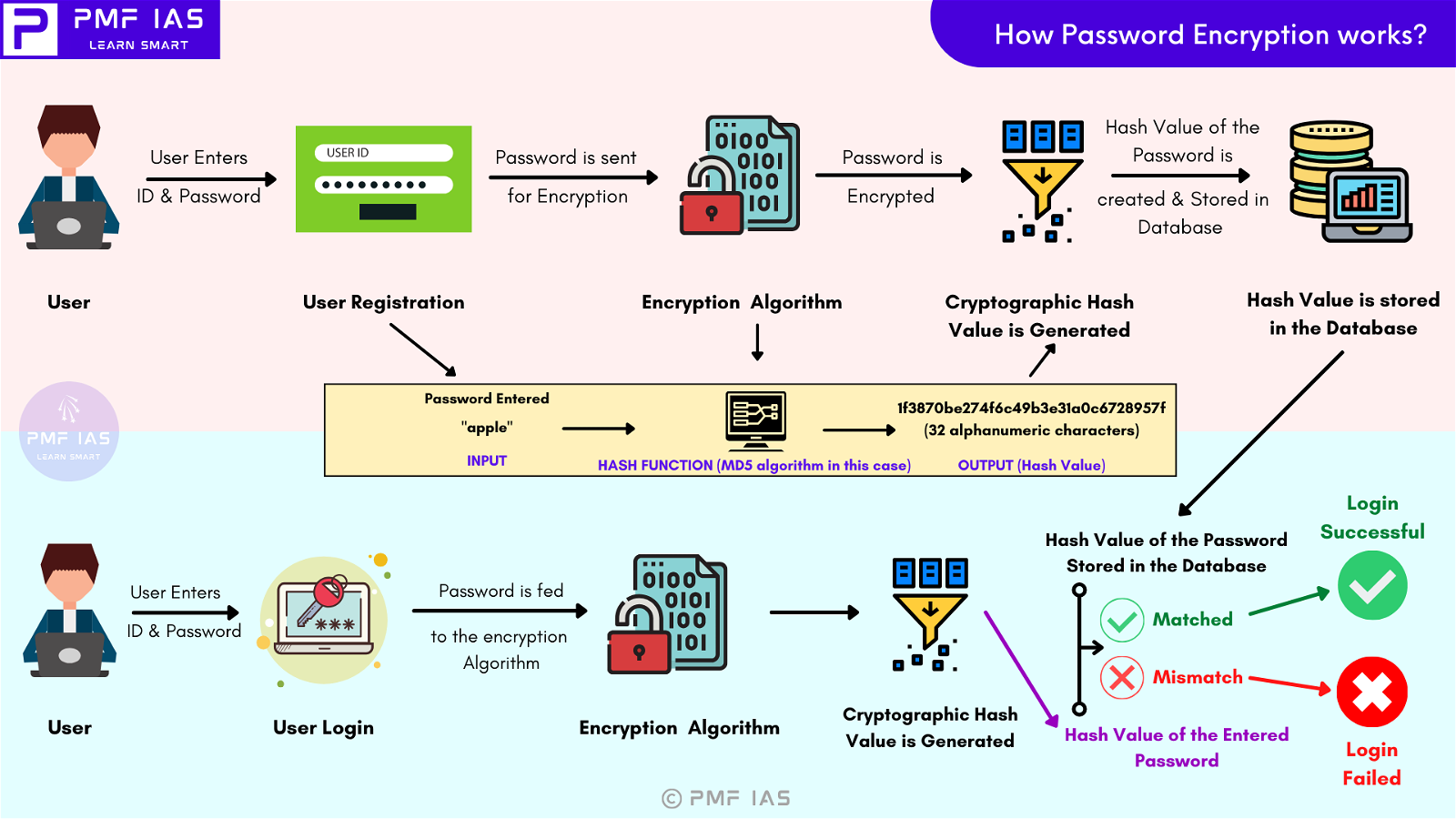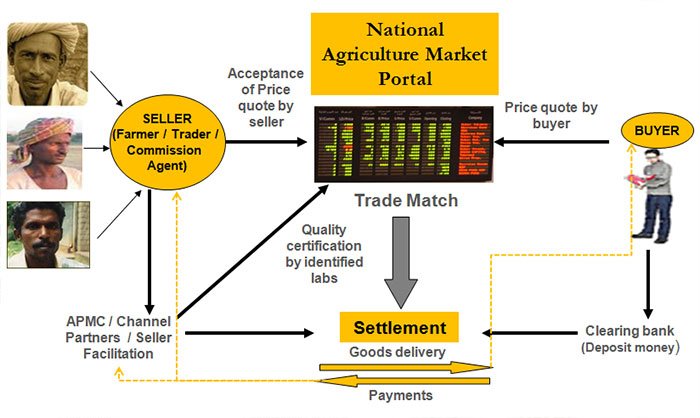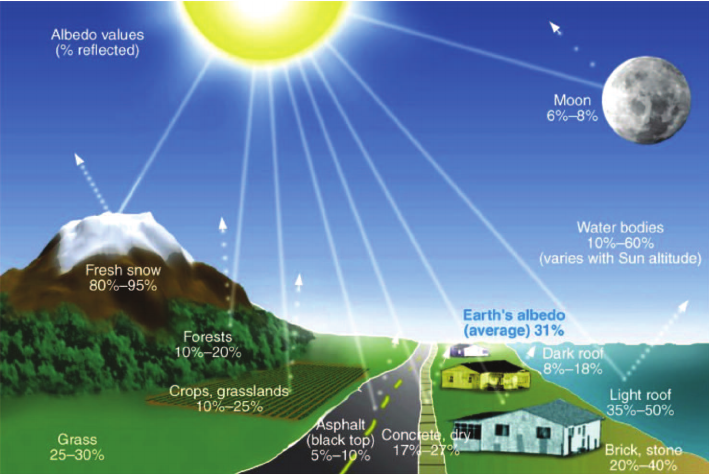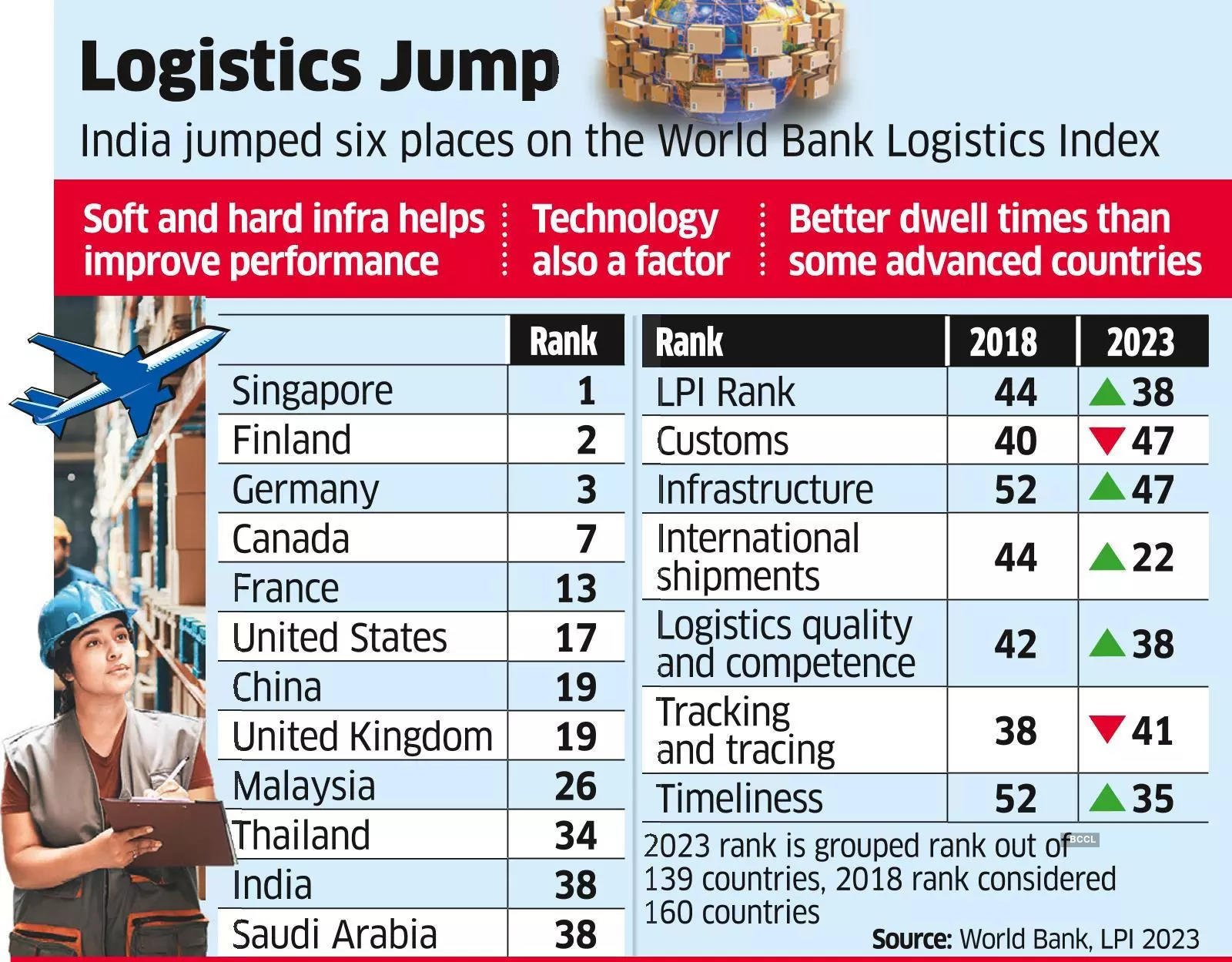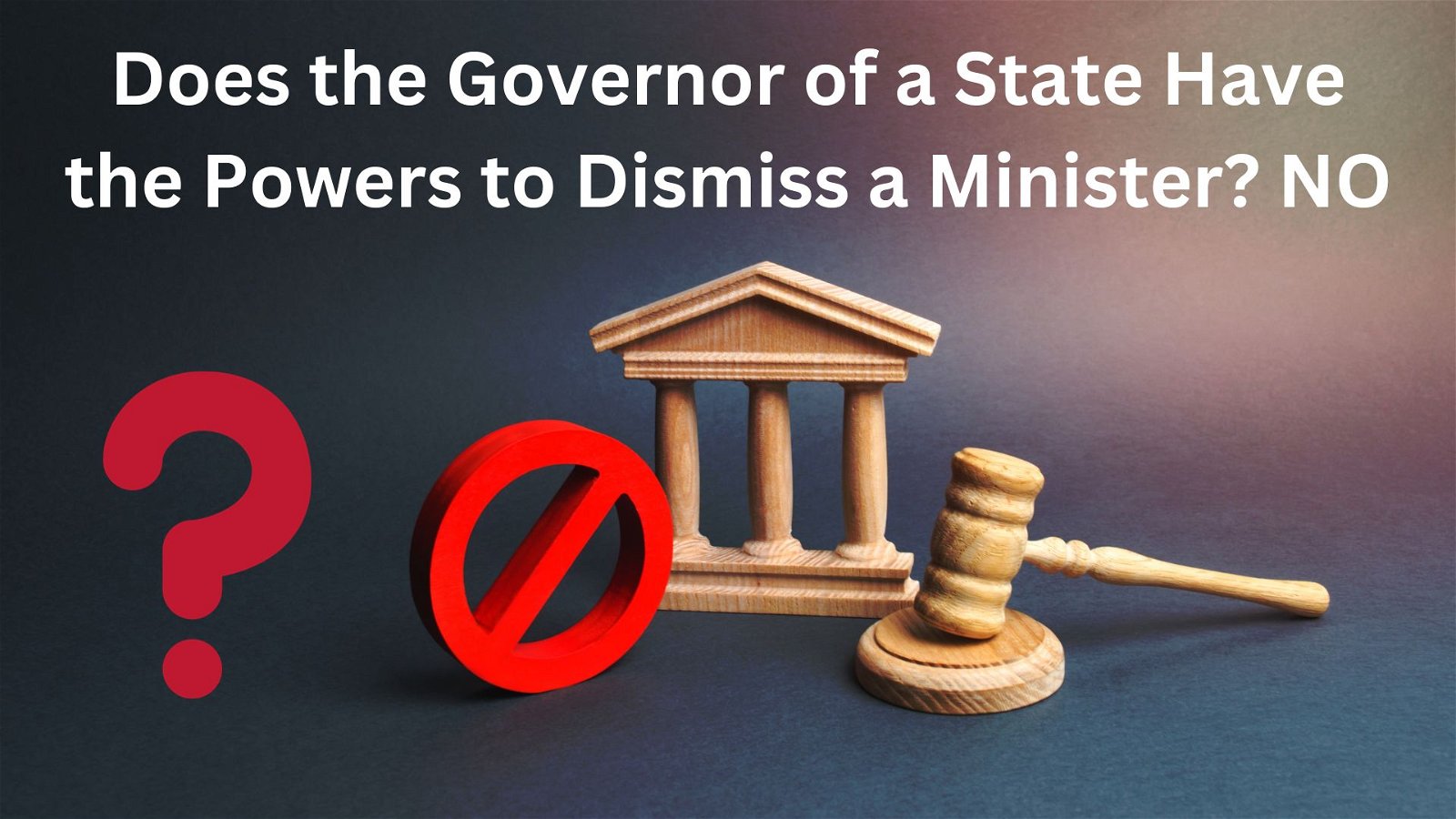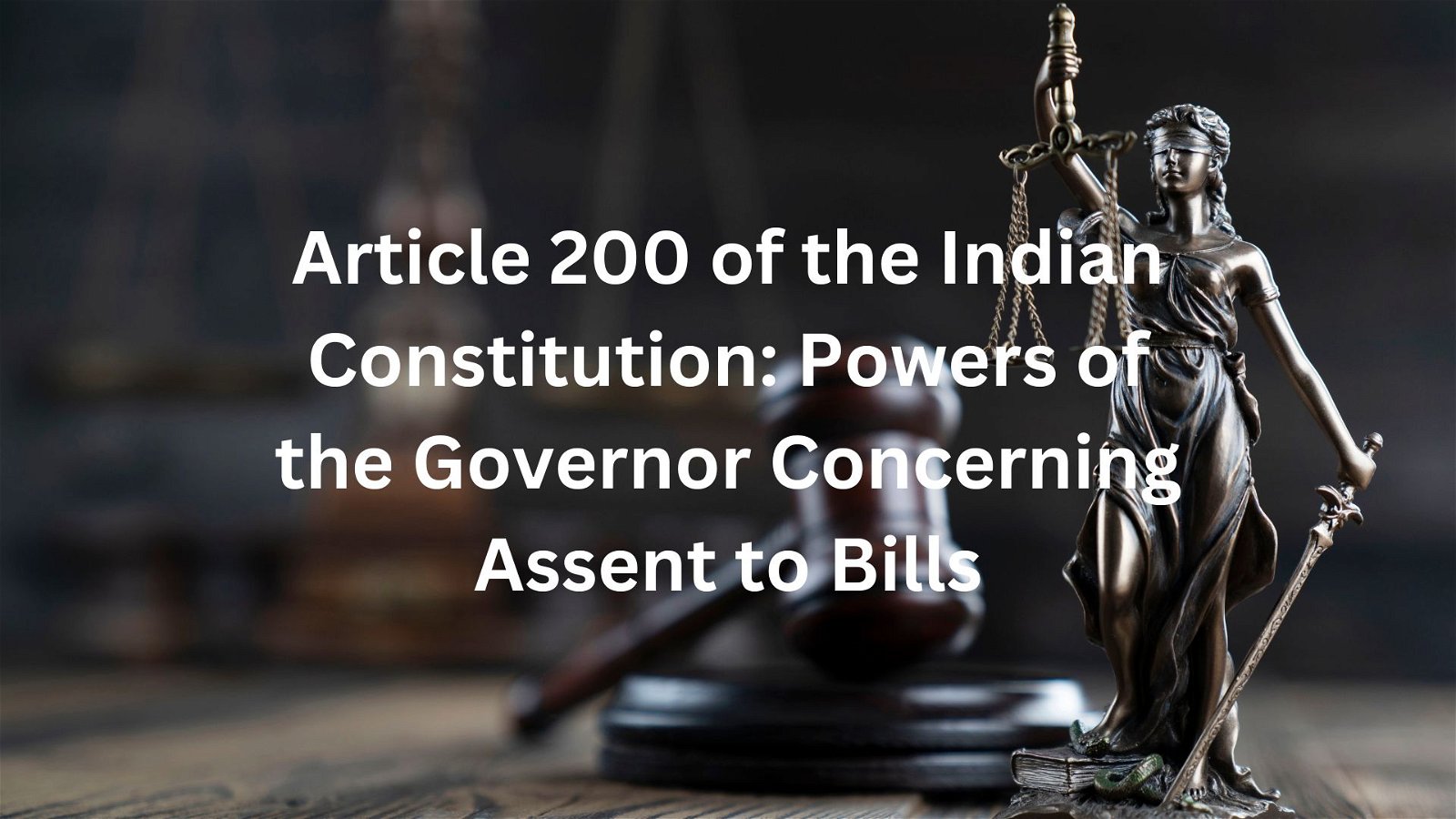
Current Affairs February 13, 2024: Smart Gram Panchayat, Periodic Labour Force Survey, Farmer’s Protest, AVGC Sector, Climate Tipping Points, Initiatives to reduce Gender Gap, Global Biodiversity Framework Fund
Subscribers of "Current Affairs" course can Download Daily Current Affairs in PDF/DOC
Subscribe to Never Miss an Important Update! Assured Discounts on New Products!
Must Join PMF IAS Telegram Channel & PMF IAS History Telegram Channel
{GS2 – MoRD – Initiatives} Smart Gram Panchayat
- Context (PIB): Union Minister of Rural Development and Panchayati Raj inaugurated the pilot project titled ‘Smart Gram Panchayat’ at Paprour Gram Panchayat, Begusarai, Bihar.
- The project aims to extend PM-WANI (Prime Minister’s Wi-Fi Access Network Interface) Service to Gram Panchayats of Begusarai and Rohtas in Bihar for the Financial Year 2023–24.
- It has been funded under the Rashtriya Gram Swaraj Abhiyan (RGSA).
- Implemented by: Ministry of Panchayati Raj.
- The Department of Panchayati Raj, Government of Bihar, in collaboration with BSNL, will ensure effective execution and operationalization of the project.
- The initiative emphasizes leveraging digital technologies to enhance access to online services in crucial sectors such as health, education, and skilling.
- Beneficiaries: Students, farmers, artisans, and Women Self-Help Groups (SHGs).
- The project will bridge the rural-urban divide and foster accountability and efficiency in local self-governance.
Rashtriya Gram Swaraj Abhiyan (RGSA)
|
To know more about the PM-WANI Scheme, visit > PMF IAS CA-August-12-2023.
{GS2 – MoSPI – Initiatives} Periodic Labour Force Survey
- Context (PIB): The Periodic Labour Force Survey (PLFS) Quarterly Bulletin for the period October – December 2023 was published recently.
- The National Sample Survey Office (NSSO) launched the PLFS in April 2017.
- Objective of PLFS:
- To estimate the key employment and unemployment indicators (viz. Worker Population Ratio, Labour Force Participation Rate, Unemployment Rate) in the short time interval of three months for the urban areas only in the Current Weekly Status (CWS).
- To estimate employment and unemployment indicators in both Usual Status and CWS in both rural and urban areas annually.
|
Key Findings of PLFS
- Increasing Trend in Labour Force Participation Rate (LFPR) for persons of age 15 years and above.
- LFPR in urban areas: increased from 48.2% to 49.9%.
- Male LFPR: increased from 73.3% to 74.1%.
- Female LFPR: increased from 22.3% to 25.0%.
- Comparison period: (Oct–Dec 2022) to (Oct – Dec 2023). (Same for the below indicators also).
- Increasing Trend in Worker Population Ratio (WPR) for persons of age 15 years and above
- WPR in urban areas: increased from 44.7% to 46.6%.
- Male WPR: it increased from 68.6% to 69.8%.
- Female WPR: it increased from 20.2% to 22.9%.
- Unemployment Rate (UR) for persons of age 15 years and above
- UR in urban areas: decreased from 7.2% to 6.5%.
- Male UR: decreased from 6.5% to 5.8%.
- Female UR: decreased from 9.6% to 8.6%.
{GS2 – Vulnerable Sections – Women} Initiatives to reduce Gender Gap
- Context (TH | FE | NDTV): At the World Economic Forum in January this year, India has launched the Alliance for Global Good – Gender Equity and Equality.
- This initiative is a step forward in promoting Gender ‘equity‘ and ‘equality‘.
Progress in India to bridge the gender equity gap
- The New Delhi Leaders’ Declaration: Reaffirmed our commitment in achieving the Brisbane Goal ‘25 by 25’ (to reduce the gap in labour force participation by 25 percent by 2025).
- The Alliance for Global Good – Gender Equity and Equality: Launched by India at the World Economic Forum in January this year.
- The passage of the Women’s Reservation Bill last year, ensuring reservation of a third of seats for women in Parliament and the State Assemblies.
- Allocations of nearly $27 billion under the gender budget in 2023-24.
- Increase in India’s female labour force participation rate, from 23.3% in 2017-18 to 37% in 2022-23 (Periodic Labour Force Survey).
- Female enrolment in higher education has gone up by 28% in the last 10 years.
- Enrolment in science, technology, engineering, mathematics (STEM) courses, the share of women is a significant 43%, which is one of the highest enrolment rates in the world.
- Improvement in the socio-economic conditions in rural areas: Over nine crore women participate in 83 lakh self-help groups.
{GS3 – Agri – MSP} Farmer’s Protest | Minimum Support Price
- Context (IE | IE | IE): Over 200 farmers’ unions from Punjab are preparing to march to Delhi. In response, the Delhi Police has enforced Section 144 across the national capital for a month.
- The farmers’ primary demand in their 12-point agenda is:
- A law to guarantee the minimum support price (MSP) for all crops.
- Determination of crop prices based on the recommendations of the Dr M S Swaminathan Commission’s report (C2+50% Formula).
|
Other Demands of the Farmers
- Full debt waiver for farmers and labourers;
- Implementation of the Land Acquisition Act of 2013, with provisions for written consent from farmers before acquisition, and compensation at four times the collector rate.
- Punishment for the perpetrators of the October 2021 Lakhimpur Kheri killings.
- India should withdraw from the WTO and freeze all free trade agreements.
- Pensions for farmers and farm labourers.
- Compensation for farmers who died during the Delhi protest, including a job for one family member.
- The Electricity Amendment Bill 2020 should be scrapped.
- 200 (instead of 100) days’ employment under MGNREGA per year, a daily wage of Rs 700, and the scheme should be linked with farming.
- Strict penalties and fines on companies producing fake seeds, pesticides, fertilisers, and improvements in seed quality.
- National commission for spices such as chilli and turmeric.
- Ensure the rights of indigenous peoples over water, forests, and land.
Reasons why farmers demand a legal guarantee for MSP
- Market conditions favouring buyers over sellers
- Farmers sell their crops, except for perhaps milk, in large quantities.
- This results in a sudden increase in supply compared to demand.
- The surplus supply puts downward pressure on prices.
- Farmers don’t have the market influence to impact their produce prices
- Unlike many industries, they can’t set the Maximum Retail Price (MRP).
- Instead, they sell their products at rates determined by prevailing supply and demand.
- Farmer’s burden
- Farmers sell their crops in bulk at wholesale rates.
- However, they purchase everything they need, such as seeds, pesticides, diesel, tractors, cement, medicines, toothpaste, and soap, at retail prices.
How can MSP be guaranteed?
- 1.Make buyers pay MSP enforced by law: For instance, sugar mills must pay cane growers a fair price within 14 days. However, this approach can face implementation challenges, as seen with recurring cane payment delays or private trade opting not to buy.
- 2.Government agencies buying all the marketable produce from farmers at MSP: Yet this is impractical both physically and financially.
- 3. Price deficiency payments (PDP): Here, the government doesn’t physically buy crops but pays farmers the difference between the market price and MSP if the former is lower. This payment is based on the quantity of crops sold to the private trade.
|
Expert’s opinion
- Fixed MSPs that ignore demand conditions can lead to imbalances in production, with oversupply of some crops and undersupply of others. So, Farmers are advised to grow crops based on market demand and current prices.
- Suggestion
- Many economists suggest providing farmers with income support rather than price support.
- This could involve transferring a fixed sum of money annually into their bank accounts, either per farmer (like PM-Kisan Samman Nidhi) or per acre (like Telangana’s Rythu Bandhu).
- Direct income support doesn’t distort the market and benefits all farmers, regardless of the crops they grow, the quantity, or the selling price.
{GS3 – Envi – CC} Climate Tipping Points
Climate Tipping Points
- According to IPCC, tipping points are ‘critical thresholds in a system that, when exceeded, can lead to a significant change in the state of the system, often with an understanding that the change is irreversible.’

When will we reach the Tipping Points of Climate Change?
- In the early 2000s, there was a general consensus among scientists that most tipping points could be reached in the event of a 4C increase in global temperatures.
- However, more recent assessments found that exceeding 1.5C of global warming risks crossing several of these thresholds.
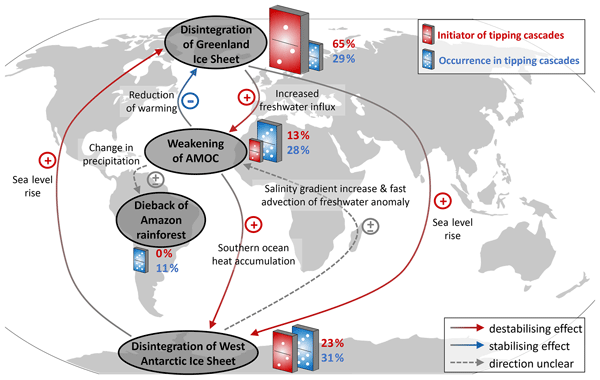
What Happens If We Reach the Most Pressing Tipping Points?
Greenland Ice Sheet
- As the world’s second-largest ice sheet, the Arctic holds enough water that, if melted completely, could raise sea levels by 7.2 metres.
- The Arctic ice sheet is warming 3 to 4 times faster than the rest of the world, adding almost 1mm to global sea levels every year.
- The melting of Greenland’s ice sheet is already occurring so rapidly that it is now the main factor in global sea level rise.
- In the past two decades, Greenland lost more than 5,100 billion tons (4,700 billion metric tons) of ice, an amount that is enough to flood the entire United States in half a metre (1.5 feet) of water.
Atlantic Meridional Overturning Circulation (AMOC)
- AMOC is a large system of ocean currents driven by differences in the density of water, which determines their temperature.
- It acts as a conveyor belt, redistributing heat throughout the Earth’s climate system by bringing it from the tropics in the Southern Hemisphere to Greenland and carrying cold water back south.
- Atmospheric warming, and increases in rainfall and ice melt, both make surface ocean water lighter, reducing its ability to sink at high latitudes and weakening the AMOC.
- A weakening of 24-39% is expected even before the tipping point is reached, something that could happen as early as 2100.
- A study published in 2021 found that AMOC is already at its weakest in over 1,600 years.
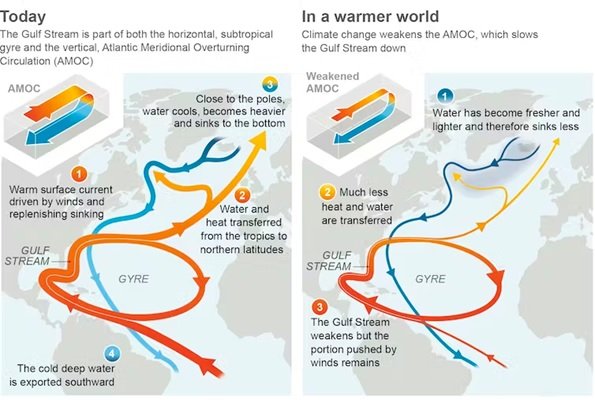
Amazon Rainforest
- As the largest tropical rainforest on the planet and home to about three million species of plants and animals, the Amazon produces about half of its rainfall by recycling moisture through evaporation and transpiration.
- Over the last 10 years, the rainforest experienced three “once-in-a-hundred-year” droughts.
- Further, deforestation has led to massive dieback, rainforests shifting from a carbon sink to a net source of greenhouse gases, as they currently emit a greater amount of CO2 than they can absorb.
Permafrost
- Permafrost holds the largest global carbon reserve from plants and animals that died and decomposed over thousands of years.
- As the climate warms and permafrost begins to thaw, carbon dioxide and methane are released into the atmosphere.
- While carbon dioxide concentrations last year were 2.4 parts per million (ppm) higher than in 2022, methane concentrations increased by 11 parts per billion (ppb).
- The spread of these highly toxic gases would add up to 0.3°C to global warming and could lead to humanity reaching other tipping points of climate change much faster.
|

Antarctic Ice Sheets
- The World Meteorological Organisation reported that temperatures in Antarctica have increased by almost 3°C over the past 50 years, with glaciers experiencing an accelerated retreat.
- Its mass losses of ice between 1992-2011 accounted for 4mm of sea level rise and almost 18% of the total global sea level rise in the period 2012-2017.
- By the end of the current century, the melting of the Antarctic ice sheets could contribute up to one metre to sea level rise.
Coral Reefs Die-Off
- Besides containing one of the most biodiverse ecosystems on earth, coral reefs:
- Protect coastlines from the damaging effects of wave action and tropical storms,
- Are a source of nitrogen and other nutrients for marine food chains,
- Assist in nitrogen and carbon fixing,
- Are a source of income for millions of people around the world,
- Generating the sand and rubble that maintain islands and cays.
- Scientists argue that reefs have already reached their tipping point and are at risk of being completely wiped out by 2050.
{GS3 – Envi – Conservation} Global Biodiversity Framework Fund
- Context (DTE): The first council meeting of the Global Biodiversity Framework Fund (GBFF) recently convened in Washington DC, United States.
- It aimed to establish guidelines for GBFF’s implementation, initially proposed during COP15 of the Convention on Biological Diversity in 2022.
Key Highlights of the Meeting
- GEF’s member governments have agreed to invest $1.1 billion for international action on biodiversity, climate change, nature renewal, and pollution control.
- Approved $918 million for 45 projects from the Global Environment Facility Trust Fund.
- Endorsed $203 million for 21 climate change adaptation projects funded by the Least Developed Countries Fund (LDCF) and Special Climate Change Fund (SCCF),
- Approved the Resource Allocation Policy and the Project Cycle Policy, which will guide the council in allocating donor funds when they become available.
Global Environment Facility (GEF)
Convention on Biological Diversity (CBD)
Global Biodiversity Framework Fund (GBFF)
|
{GS3 – IE – Banking} UPI goes Global
- The list includes France, UAE, Mauritius, Sri Lanka, Singapore, Bhutan, and Nepal, as per GoI.
- Recently launched in Sri Lanka and Mauritius.
- Bhutan was the first country to enable UPI transactions through the BHIM app.
- Last year, a report suggested that Japan might also join India’s UPI payment system and promote cooperation on the digital identity system.

{GS3 – IE – Industry} AVGC Sector
- Context (TH): India’s Animation, Visual Effects, Gaming and Comics, and Extended Reality (AVGC-XR) sector to become a $26 billion industry by 2030.
What is the AVGC Sector?
- Animation, visual effects, gaming, and comics (AVGC) is an industry that includes animation, visual effects, gaming, and comics.
- The AVGC sector in India has the potential to become the torch-bearer of “Create in India” and “Brand India.”
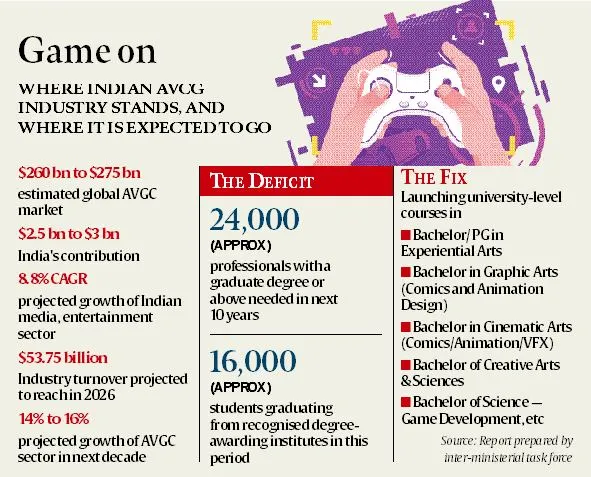
Status of the AVGC Sector in India
- The sector is growing at 30-35% annually.
- At present, India contributes about $2.5-3 billion out of the estimated $260-275 billion global AVGC market.
- It employs about 2.6 lakh professionals; expected to create over 23 lakh jobs by 2032.
- It has the potential to become a $26 billion industry (5% of the global market) by 2030.
Growth Drivers of the AVGC Sector
- Growing OTT user base: Over-the-Top user base is expected to grow at a CAGR of 7% between 2021 and 2024 with a penetration of 45.8% in internet users.
- Advent of New Technologies like Augmented Reality and Virtual Reality.
- Growth of Smartphone Users: In 2021, the number of smartphone users in the world stood at 6.3 Bn and is expected to reach 7.5 Bn by 2026 (at a CAGR of 4% between 2021 and 2026).
- Wide spectrum of applications: Global animation and VFX in advertisement is projected to grow at a CAGR of 10.9%. Gaming is growing at a CAGR of 12%, with Gamers demanding high-quality productions with engaging VFX and realistic animation.
- Growing 5G Presence: By 2026, 5G mobile subscriptions worldwide are forecast to exceed 3.5 Bn, led by Asia-Pacific, North America, and Europe. This is expected to bring a telecom revolution.
- Increased R&D Investments: E.g. EA Sports spends up to 25% of its total expenditure on R&D with the proportion of spend increasing every year.
- Surging Popularity of Comic Events, such as Comic-Con, have gained popularity across world providing fans the opportunity to interact with favourite content creators, receive sneak peeks, etc.
Challenges faced by the AVGC Sector
- Non-availability of data such as employment, industry size, education intuitions, etc. for the AVGC sector, makes decision-making tougher for entities.
- Absence of adequate training infrastructure, deterioration in the quality of training being delivered to students, impacting the quality of output and human resources for the AVGC industry.
- Skill Gap: The AVGC sector in India will require over 20 lakh skilled professionals by 2024. However, the current talent pool is only about 4 lakhs.
- Legal uncertainty: E.g. Karnataka High Court struck down substantial provisions of the Karnataka Police (Amendment) Act, 2021, which prohibited online gambling and skill-based gaming platforms.
- Lack of a dedicated fund for the sector and ambiguities in GST laws on skill-based games hinders its growth.
- There is no apex institute in India for the AVGC sector, unlike other sectors such as engineering, design, management, packaging, etc.
- No national-level policy level framework exists for the AVGC-XR Sector.
- Less focus on Research Development.
- Lack of original Indian intellectual property as most work in this sector is outsourced.
Way Forward
- Model Intellectual Property Licensing Agreements (IPLAs) may be developed by the AVGC promotion nodal agency.
- Collective licensing agreements should be promoted among the existing players to create individual intellectual property and prevent IP rights infringements.
- Indian AVGC companies should initiate conversations with Global AVGC companies to offer their servers for small Indian developers to create their own games.
- A platform for pro bono legal and technical consultation on IP protection for developers and designers, like the Patent Facilitation Program under the Department of Science & Technology may be established in coordination with the industry-led incubators and accelerators.
{Prelims – In News} GROW Report and Portal
- Context (PIB): The NITI Aayog (National Institution for Transforming India) recently launched Greening India’s Wastelands with an Agroforestry (GROW) report and portal.
- This multi-institutional effort utilizes remote sensing and GIS to assess agroforestry suitability across all districts in India.
- An Agroforestry Suitability Index (ASI) was developed, by utilizing thematic datasets, for national-level prioritization based on thematic datasets.
- The report provides state-wise and district-wise analysis, supporting government departments and industries in greening and restoration projects.
- The GROW portal allows universal access to state and district-level data.
- It promotes agroforestry and sensitizing extension programs.
{Prelims – In News} Quishing attack
- Context (HT): GoI has issued an advisory to the people regarding Quishing cyber-attack.
- It is “QR” + “Phishing”. A fake QR code is used for faking websites (Phishing).
- Increased use of UPI has raised the incidences of Quishing cyber-attacks in India.
- Some QR codes also contain malicious files or mirroring software, which gives access to all the information in your phone to the scammer.
- It is advised that one does not click on any unfamiliar links that appear after scanning a QR code.
How does quishing works?
- Scammers create a fake QR code: They can place it on stickers, posters, or even overlay it on legitimate QR codes in public places like parking meters or petrol pumps.
- The code looks innocent: It might appear to link to a website, or payment portal, or offer a discount or reward.
- When scanned, it directs you elsewhere: Instead of taking one to the intended destination, the code redirects you to a malicious website.
- The website aims to steal your information: It might look like a real website (e.g., your bank) and trick one into entering login credentials, personal details, or financial information.
- Malware can also be downloaded: Malicious codes hidden within the QR code can infect the device, stealing data or giving attackers remote access.
QR Code
- A QR code (quick-response code) is a type of two-dimensional matrix barcode invented in 1994.
- It consists of black squares arranged in a square grid on a white background, including some fiducial markers, which an imaging device can read.




![PMF IAS Environment for UPSC 2022-23 [paperback] PMF IAS [Nov 30, 2021]…](https://pmfias.b-cdn.net/wp-content/uploads/2024/04/pmfiasenvironmentforupsc2022-23paperbackpmfiasnov302021.jpg)

